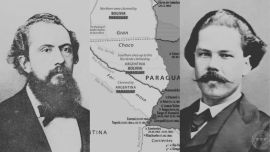Those that I fight I do not hate,
Those that I guard I do not love.
W. B. YEATS
An Irish Airman Foresees his Death
I do not believe in feigned obedience or revolutionary violence. There is only one demon with different names. It is hungry death that devours fools and sages with equal appetite. It enthusiastically encourages both defenders of the established order and ideological kamikazes as long as they deliver victims to its door. For death, all fanaticism is identically beautiful. I believe rather in the need for justice, the kind that does not seek merely to punish the criminal, a secondary end, but one that aims to paralyze the monster that criminals engender with their abominable deeds.
I do not share therefore the belief that mass murder arises from a clash of ideologies. These mutate throughout history. What remains unalterable is the torture, rape and subjugation, the rejoicing in the suffering of others. All these manifestations of the dark side of the force were present during the Process of National Reorganization, as Argentina’s dictatorship of 1976-1983 tellingly chose to call itself.
The military, like orators feasting on their own words, really believed in the power of their hallucinatory rhetoric to magically alter reality.
Even after their dream of reinventing Argentina in their own “Western and Christian” likeness collapsed, the military still thought that if they had only won the battle of words their triumph would have been complete. “We won the war against terrorism but we lost the cultural battle,” they lamented after the return of democracy.
It was not only political or religious goals that motivated the genocidal plans of the military. It was their subterranean thirst for blood that found an echo in a large sector of the population. It is a hushed lust for death that makes humans choose flags dividing “friends” from “enemies” to achieve the unspeakable goal of extermination.
It does not matter in whose name torture is applied; the scene is always the same, the strong subjecting the weak. The ideology of the tormentor must be ignored if we are to understand the true nature of the beast.
Since I write about Argentina, I feel obliged to clarify that I do not endorse the theory of “the two demons.” The mass murder committed by the dictatorship was state terrorism and a total violation of human rights. The military imposed a bloodthirsty and systematic plan of annihilation against a large segment of Argentina’s youth whose modern ideas offended the medieval sensibilities of middle-aged military men.
What I propose instead is an additional layer of reflection on the subconscious motivations of that plan of annihilation. We must reconsider to what extent it was not the animal blood appetite, present in all humans, that really inspired the crimes of the dictatorship.
Mass murder also requires the assistance of the chimera of loyalty, without which it is difficult to differentiate “friends” from “enemies.” Loyalty creates a personal relationship between leader and troops that transcends legal norms. It is a form of alternative political organisation to the law, as Holocaust historian Timothy Snyder warns in his book On Tyranny.
The concept of blind allegiance, of due obedience, opens the door to the justified extermination of the designated victims of the established order.
Crimes with a large number of victims, such as those committed at the ESMA death camp, no matter how secretly they are carried out, create by their own magnitude a sort of “silent truth” that spreads across the whole of society.
Without knowing exactly what is happening, we know enough to understand that it would be dangerous to challenge authority. To erase a selected group of people from existence would be a self-defeating act did it not serve the ulterior purpose of subjecting all of remaining society to ironclad control.
This “silent truth” hangs in the air, like a pause in music, like a forgotten melody, hidden from our consciousness.
In her book A Problem From Hell, a study on the United States’ response to genocide in the 20th century, Samantha Power makes a distinction between “information” and “knowledge.” A citizen of Berlin in 1941 could, through their own eyes, obtain the “information” that the Jewish family next door had disappeared, without fully “knowing” that this was part of a broader plan of total annihilation.
Totalitarian leaders in fact require that the population surmise their intentions without fully realising them.
That is why in Argentina death camps such as ESMA were located in full public view, between Lugones and Libertador avenues, two thoroughfares with a large volume of traffic in the capital city of Buenos Aires.
If the military had really not wanted the population to grasp what it was up to, it would have carried out its killing far from the public eye. The “flights of death” would have taken off from secret bases hidden from civilian populations, not from Aeroparque, in full view of everyone.
The military wished us to know enough to discipline our behaviour, that is why they committed their crimes literally right under our noses, while obscuring the details that could incriminate them personally in their frightful work.
The public debate of the crimes of the dictatorship continues to provoke commotion even now, four decades after the events took place. Relativism, which is the politically correct face of negationism, gains more adherents every day.
The American writer David Rieff, son of Susan Sontag, in his book In Praise of Forgetting questions the concept of “historical memory” and rejects the use of the past as a political weapon. Rieff asks himself if it is not wiser to forget in the case of societies such as Colombia or South Africa, where the process of seeking justice for mass crimes could result in a civil war.
I propose the concept of detailed awareness. You can not forget what you do not know precisely. The road to oblivion passes through the meticulous reconstruction of the events that have traumatised us. I can only forget what I know with certainty. Mystery endures, keeping us wide awake. Only the truth sleeps.
The dictatorship justified the bloodbath to which it subjected Argentina by proclaiming the existence of a threat of national dissolution at the hands of the armed guerrilla groups. The fact that the guerrillas failed to occupy any territorial space, not even a single town block, does not unsettle those who still subscribe to this paranoid view.
The Military Junta itself, in its book El terrosismo en la Argentina, published in late 1979, listed all the deaths caused by the guerrilla groups, a total of 687 mortal victims. To inflate the number the book included in this number people actually killed by the ESMA, such as the diplomats Elena Holmberg and Hector Hidalgo Solá.
Taking into account that some guerrilla attacks caused multiple deaths (the case of the bombing of the Coordinación Federal building in July 1976 that left 23 dead) it is clear that the total number of guerrillas who participated in murder was of at most a few hundred.
If the military’s real objective had been only to kill off the guerrillas responsible for such crimes, the planned extermination of thousands of people who never participated in any violent deed whatsoever does not make sense. But as the military officers later made abundantly clear when they lamented having lost the “cultural battle,” theirs was not a territorial war.
They were fighting for the minds of young Argentines. Such a war by definition included the physical annihilation of those minds considered by them unrecoverable, even if they had committed no crime.
That the military were engaged in a war against imaginary enemies is illustrated by the departure into exile of the editor of the Buenos Aires Herald, Robert Cox, at the end of 1979, because of the violent threats he received. A report by the US Embassy, based on conversations with members of the dictatorship’s security forces, demonstrates the degree of “conspiranoia” that informed the dictatorship’s decisions.
“For these men Cox became a symbol of what they hate. For them Cox is a symbol of Zionism and Jewish conspiracy.
Vicious anti-Semites, these individuals are convinced that Cox is in spirit, and perhaps in fact, Jewish. (He is not). Many of the recent threats to Cox had overt or implied elements of anti-Semitism. For them Cox is a symbol of liberalism. To these men liberalism is the handmaiden of communism and the protector of terrorism.
Cox’s spirited defense of human rights convicted him in their eyes of being a liberal.”
The sleep of reason engenders monsters, as was clearly seen in 1970s Argentina, when the insane conspiracy theories of delusional generals resulted in the largest mass crime in the country’s history.
ABOUT ASTIZ
The “infiltator” at the heart of Uki Goñi’s book, Alfredo Astiz, was nicknamed the “Angel of Death” for his crimes committed during the country’s last military dictatorship (1976-1983). Though the Navy captain has been implicated in dozens of atrocities, including kidnappings, acts of torture, murders and the stealing of newborns from their mothers, his most infamous act was his work delivering dissidents to the military junta as an undercover agent. Forty years ago, on December 8, 1977, Astiz commanded the operation that culminated in the kidnapping and abduction of 12 people, including some of the founders of Mothers of Plaza de Mayo and two French nuns, Léonie Duquet and Alice Domon. Already facing a life sentence in prison for his crimes, just two weeks ago Astiz was handed another life term in jail for a series of atrocities that took place at the ex-ESMA Navy School of Mechanics.






























Comments